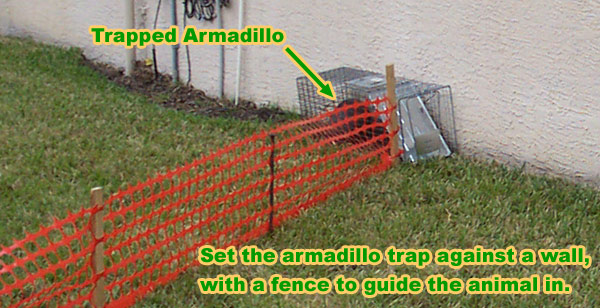Armadillos are neat animals! They have many unique traits. They are often victims of automobiles, and often become roadkill, because they are not always alert to cars, and often jump up when startled, which increases the risk
of injury with automobiles.
Depending on where you live in the country, armadillos can be a real problem. These small creatures aren’t invaders of the attic or the home itself, but they are industrious diggers and can do surprising damage to a yard and garden. In some cases, the burrowing of an armadillo can compromise the structural integrity of some structures, fences and walls.
If you want, you can call a professional armadillo
control expert in your town by clicking on my
National Wildlife Control
directory, which lists experts who I recommend in every USA city and town.
An armadillo in your yard will create a den. Because they are prey animals, armadillos are able to fortify themselves in their burrows, making it next to impossible to dig them out. This animal is an excellent digger. Covering up an armadillo burrow will simply result in wasted time; the animal will dig itself out in a short time. To get rid of an armadillo, the first step is to consider finding a way to eliminate the food source. The nomadic nature of the armadillo is advantageous to those who want to get rid of it. Beyond a source of food, the armadillo has no loyalty to your specific plot of land. Eliminate the food and the creature will go elsewhere.
Insects make up a large portion of what the armadillo eats. By creating an environment unfriendly to insects, grubs and worms, you will help to encourage the armadillo to go on the better and brighter things. Simple changes around the home can help discourage an overpopulation of food insects. Loose soil, like that found in many decorative garden beds is often damp and warm from a layer of mulch. This situation is the perfect breeding ground for grubs and invertebrates. Replacing mulch with decorative pebbles can make a huge difference. Good drainage on your property is key; armadillos like loose, moist soil conducive to insect breeding, and drainage will allow the soil to remain firm and dry.
People have tried many different things when it comes to armadillo deterrents and prevention. Most chemical deterrents are worthless. It is true that an armadillo has a very sensitive sense of smell, and some companies think exploiting that attribute can create a viable defense against the animal. In truth, leaving mothballs around will not deter an armadillo. The plated animals often just steps over the carcinogen-based ball or covers it over with a layer of dirt. Similar responses are seen with the urine of predators. Ultrasonic and electric barriers are the most interesting deterrents marketed. The theory is that an animal will sense the electric or ultrasonic current before it crosses it. In reality, most animals don’t recognize an ultrasonic frequency as a warning of danger, and they don’t notice an electric barrier until they have already crossed it.
No approved poisons for armadillos are on the market, and poisoning an animal that may crawl under your home and decompose is not recommended anyway.

The best way to remove an armadillo is to humanely trap and remove the animal from the property. This can be accomplished with a baited, live trap. Build up the confidence of the armadillo with a few days of leaving the trap out, baited but not set. Allow the animal to take the food from the trap. After a couple of days, the armadillo will be primed for trapping and removal. Finding good bait may prove difficult, especially if the food source is still abundant in the yard. If you do manage to trap an armadillo, relocation is often easy. Like other nomadic animals, a relocated armadillo will remain in the new location if the area is stocked with food and has the means for adequate shelter.
The best way to keep an armadillo from becoming a problem is to install a perimeter fence. Because armadillos are not inclined to climb, the depth of this fence into the soil is the most important factor. Placing the fence a few feet under the soil and sloping it outward at an angle will discourage any armadillos from burrowing underneath it.

How to catch a armadillo under the shed - Armadillos like to live
under sheds, because the space provides a sheltered, safe environment.
Armadillos live in burrows, so they dig a hole under the shed, often
tossing dirt out the side of the shed. This will give you a clue
about where the burrow is located. The best way to trap the armadillo
is to either find a hole that the animal has dug to gain access under
the shed, or to block off the perimeter using steel mesh or wooden
blocks, to force the armadillo to go through one area. Once you have
a single area isolated, you can set a cage trap right on the opening,
to catch the armadillo as it tries to go through. Be sure to use a
large and sturdy cage trap, with at least a 12 inch high door, and 32
inches long. There's usually only one animal under the shed, but you
can test by blocking a hole with some crumpled newspaper, to see if
another animal pushes it out of the way. After you've trapped the
animal and relocated it at least five miles away, and you are sure
there are no more there, install an exclusion barrier, again using
steel mesh or wood or concrete blocks, around the perimeter of the
shed so that no future armadillos can get under there. It helps to
dig a trench and install the steel mesh at least a foot, preferrably
two, into the ground, or else the armadillo will be able to dig under
your barrier and get under the shed again.
how to trap an armadillo - Buy a large steel cage trap, at least 30" long, like the Havahart 1079. 2) Place the trap in areas armadillos walk...
I wrote this website to provide armadillo information in the case that you have
a armadillo problem and need to make an informed decision about what to do. If you
have any additional questions you may email me, but I do know from experience
that armadillo removal is not simple. If you need professional help solving your
wildlife conflict, I recommend that you talk to a professional armadillo
control expert in your town by clicking on my
National Wildlife Control
directory, which lists experts who I recommend in every USA city and town who can
help you with your armadillo issue.